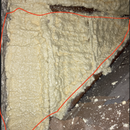Closed Cell Foam in Old Wall Assembly
Can someone point me at the rules for using foam on a wall assembly? My contractor came to spray the ceiling (finally!), it all went well there, however he also sprayed 4″ closed cell HFO foam in a small section of a 2×4 wall. The wall assembly is “old” stucco + tar paper adhered to shiplap. See the attached section.
I’m concerned about moisture now since this wall cannot dry to the interior. Do I need to ask the contractor to remove this small section? See photo below.
Is there any risk to the exterior stucco or shiplap?
GBA Detail Library
A collection of one thousand construction details organized by climate and house part










Replies
Bump.
Closed cell spray foam is vapor impermeable. You want the wall to be able to dry in both directions from the foam, otherwise you have a vapor trap.
You probably won't have a problem here. On the inside, you should have drying to the interior. On the exterior, the only thing to think about is that stucco. I don't have much experience with stucco, which is why I didn't comment before. Close cell spray foam in thick enough layers -- which you have here -- is a vapor barrier. If you have an air gap in the exterior of that wall assembly that is probably enough to prevent any major issues though, as long as the gap is vented to the exterior somewhere.
Bill
Right there is no air gap. It is literally stucco attached to felt paper attached to wood — now attached to foam.
I’ve asked the contractor to grind it out — down to 1” or less.
If you're going to have the spray foam removed, you probably want to remove pretty much all of it -- leave NO layer. A little bit of remnant foam here and there is OK, but try to avoid having an actual layer as much as possible.
Bill